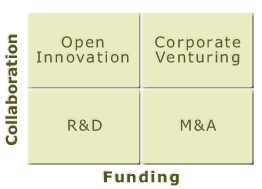Corporate Innovation and Growth

What is your next
move?
Companies need innovation to compete and grow. They may do really
well, growing year on year for some time, and then at some point
they reach a glass ceiling to growth and nothing seem to make any
real change. Peter Drucker the father of management science once
said:
"A Business Enterprise has two main functions: innovation and
marketing. Everything else is just expense!"
(Read
more about companies Innovation Challenges)
History
shows that companies will only continue to grow and prosper in the
long run if they are capable of morphing into new technology and
business areas.
They
need to constantly look for ways to drive their growth and competitive
advantage in the future. And they have been trying it, one way or
the other, all along.
However
confronting an increasingly competitive global economy and the emergence
of innovation centers all around the world makes it harder and harder
for companies to go about innovation with a casual and ad-hoc approach.
About 62% of businesses report they struggle to keep pace with innovation
necessary to help them grow.
The most successful companies are those that have developed an aggressive
innovation plan and have made it a critical component of their growth
strategy. They also realize that in a world of widely distributed
knowledge, companies cannot afford to rely entirely on their own
research.
They use Corporate Open Innovation and use it systematically and
effectively.
To
be an open innovator, a company employs external collaborators to
originate or develop innovations. This is different from traditional
'closed' innovation, where in-house research and development (R&D),
production engineering and marketing departments collaborate to
produce new products and services.

What
are the options?
Corporations
use a variety of approaches to innovate and grow, including internal
R&D, incubation of
new businesses, alliances, strategic investments (Corporate Venture
Capital) or acquisitions.
Let's
review each option:
- Internal
R&D
For
obvious reasons internal R&D is always pursued as the first
option.
This works well for extensions to existing products, but rarely
for game changing ones. Major innovations require flexible timelines
and unboxed creativity.
In established companies internal teams are frequently constrained
by technical and cultural factors, limiting the possibilities.
Furthermore it is challenging to manage long-running, parallel
projects within the organization without interfering with day-to-day
business.
- Merger and Acquisition
Usually acquisition is considered as the next option.
It can be very fast and it can provide side benefits such as customer
base. However there is not much room for mistake. The cultural
conflicts, integration problems add to the challenges.
- Corporate Venture Capital
Making many small external investments (e.g. startups) is a less
pursued option due to high overhead, long time horizons and uncertainty.
Nevertheless being done right this can be an inexpensive and attractive
option.
|

